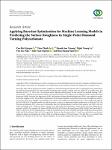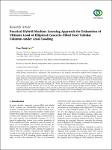Browsing by Author Tien-Thinh Le
Showing results [1 - 6] / 6
This paper deals with the prediction of surface roughness in manufacturing polycarbonate (PC) by applying Bayesian optimization for machine learning models. The input variables of ultraprecision turning—namely, feed rate, depth of cut, spindle speed, and vibration of the X-, Y-, and Z-axis—are the main factors affecting surface quality. In this research, six machine learning- (ML-) based models—artificial neural network (ANN), Cat Boost Regression (CAT), Support Vector Machine (SVR), Gradient Boosting Regression (GBR), Decision Tree Regression (DTR), and Extreme Gradient Boosting Regression (XGB)—were applied to predict the surface roughness (Ra). The predictive performance of the bas... |
The use of geopolymer concrete (GPC) in common load-bearing structures is still limited, mainly due to the lack of specific design procedures and limited understanding of the stress–strain behavior under uniaxial loading. The present work investigates the mechanical responses of GPC under axial compressive load by conducting a large number of experiments. For this purpose, 198 samples with three GPC mixes were designed, including concrete grades of 30, 40, and 50 MPa. The samples were prepared following the ASTM standards to determine the stress–strain relationship under compression. The results showed that fly ash-based GPC had average elastic modulus values of 30.424, 31.497, and 33... |
This work addresses the prediction and optimization of average surface roughness (Ra) and maximum flank wear (Vbmax) of 6061 aluminum alloy during high-speed milling. The investigation was done using a DMU 50 CNC 5-axis machine with Ultracut FX 6090 fluid. Four factors were examined: the table feed rate, cutting speed, depth of cut, and cutting length. Three levels of each factor were examined to conduct 81 experiment runs. The response parameters in these experiments were measurements of Ra and Vbmax. |
In this study, a hybrid machine learning (ML) technique was proposed to predict the bearing capacity of elliptical CFST columns under axial load. The proposed model was Adaptive Neurofuzzy Inference System (ANFIS) combined with Real Coded Genetic Algorithm (RCGA), denoted as RCGA-ANFIS. The evaluation of the model was performed using the coefficient of determination (R2) and root mean square error (RMSE). The results showed that the RCGA-ANFIS (R2 = 0.974) was more reliable and effective than conventional gradient descent (GD) technique (R2 = 0.952). The accuracy of the present work was found superior to the results published in the literature (R2 = 0.776 or 0.768) when predicting the... |
This work aims to develop a novel and practical equation for predicting the axial load of rectangular concrete-filled steel tubular (CFST) columns based on soft computing techniques. More precisely, a dataset containing 880 experimental tests was first collected from the available literature for the development of an artificial neural network (ANN) model. An optimization strategy was conducted to obtain a final set of ANN’s architecture as well as its weight and bias parameters. The performance of the developed ANN was then compared to current codes (AS, EN, AIJ, ACI, AISC, LRFD, and DBJ) and existing empirical equations. The accuracy of the present model was found superior to the res... |
This paper reports the results of soft computing-based models correlating L and N-type Schmidt hammer rebound numbers of rock. A data-independent database was compiled from available measurements reported in the literature, which was used to train and develop back propagating neural networks, genetic programming and least square method models for the prediction of L-type Schmidt hammer rebound numbers. The results show that the highest predictive accuracy was obtained for the neural network model, which predicts the L type Schmidt hammer rebound number, with less than ±20% deviation from the experimental data for 97.27% of the samples. The optimum neural network is presented as a clos... |



